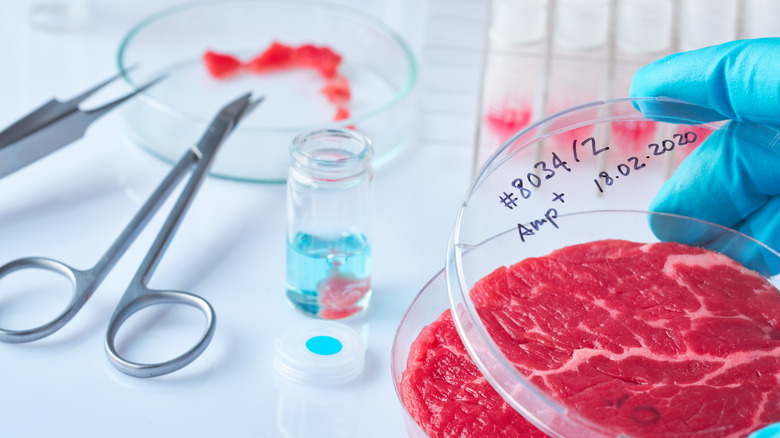The Debate On How To Classify Lab-Grown Meat Is Raging
Pea protein burgers, coconut jerky, and jackfruit pulled pork are all signs that our idea of meat is changing, and that includes products developed through cellular agriculture. Unlike the other plant-based alternatives, Scientific American describes that lab-grown meat is created by taking a muscle biopsy from an animal, collecting its stem cells and multiplying them to create fibers that bulk into muscle tissue. A slaughter-free alternative, the controversy surrounding how to accurately label lab-grown meat is increasing.
According to studies done by the University of California, Berkeley, people who consume over 100 grams of meat daily create a total of 7.2 kg of carbon dioxide emissions in comparison to vegans who average a mere 2.9 kg. Due to the resources needed (grain, water, fuel, etc.), raising animals proves to be unsustainable, which has led many to adopt veggie-forward diets in response. Although cultured meat isn't plant-based or vegan, it does offer a solution to reduce environmental impact and feed the world's carnivores at the same time. The question is: how should this new type of meat be identified against slaughtered animal products and plant-based options?
Cell-based meat needs its own classification
In 2019, the FDA partnered with the USDA to regulate cellular products. However, it wasn't until late last year that they launched a forum regarding how the process of making meat should be regulated, along with how it should be labeled. Food Dive reports that there were 1,179 responses that came mainly from agricultural companies and departments (traditional and cellular), with both parties ultimately agreeing that cell-based meats need specific labeling to differentiate them from products that come from slaughtered animals.
The Agricultural & Applied Economics Association explains that traditional animal agriculture has the potential to be negatively impacted if cellar agriculture is labeled the same way as meat. Rather than misinform consumers, suitable alternatives that currently provide transparency include mock, artificially grown tissues, in-vitro meat, man-made, cultured meat, manufactured animal tissue, cell-cultured, and cell-based. Vague terms such as clean meat or cultivated infringe on the traditional meat industry and insinuate, rather than explicitly call themselves imitations.
Interestingly, because cell-based meat is engineered in a lab, this raises questions on whether meat should be labeled as synthetic, and whether or not GMOs and industrial chemicals should appear on packaging. While these terms might initially ward off consumers, Michigan State University explains that using GMO processes can actually optimize cells and might even be able to delete allergy-causing molecules.
Although there is a lot for industry specialists to ponder, the increase in cellular food industries means that debates are far from over.

